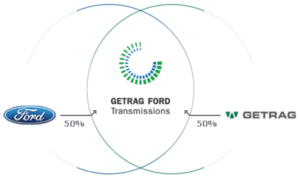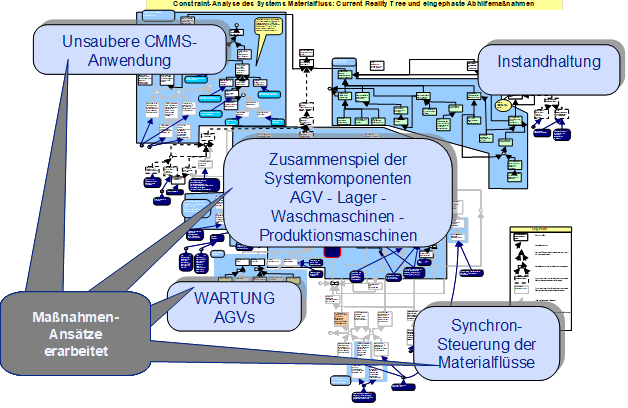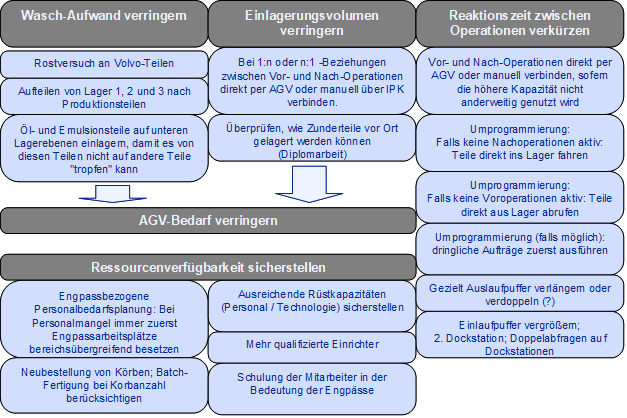Constraint analyses at GETRAG FORD Transmissions
By Georg Ingenbleek 1 and Andreas Gillessen
Controlled or not – bottlenecks (constraints) determine the performance of every system. Especially when it is running under full load. Abels & Kemmner identified the bottlenecks at GETRAG FORD Transmissions in a project to avoid bad investments during expansion.
At full capacity, the production output of a production system cannot be increased “just like that”. GETRAG FORD Transmissions, Cologne, which operates a three-shift system, is currently only able to meet the sustained increase in market demand with additional, expensive shifts on Saturdays. It shouldn’t stay that way forever. Abels & Kemmner was commissioned to carry out a bottleneck analysis before any expansion investments were planned. This should systematically identify all influencing factors that limit production output in advance, reveal their interdependencies and quantify potential for optimization in order to further optimize capacities and cost ratios. The most efficient method of identifying bottlenecks and limitations (constraints) of a system is constraint analysis. Constraint analysis is a tool for efficiently controlling economic activity. Its versatility allows it to be used for everything from strategic corporate planning to operational decision-making. The first starting point for any constraint analysis is to determine the system under consideration.
At GETRAG FORD Transmissions, the production of the individual transmission components (shafts and wheels) was selected for this purpose. The second starting point for constraint analysis is the assumption that economic systems are only successful if they grow. For this reason, system analysis always focuses on the limits of the system under consideration. For GETRAG FORD Transmissions, this meant identifying all bottlenecks in the production system under consideration, whether caused by products, processes or resources and their interactions. Here, not only physical constraints (employees, equipment, facilities, etc.) were considered, but also limits such as qualification level, thinking in overall contexts, IT systems, maintenance, suppliers, etc. Based on these two starting points, “system definition” and “consideration of system boundaries”, the consultants from Abels & Kemmner set to work together with a project team from GETRAG FORD Transmissions. Within a short space of time, the complex production process was described in all its segments and facets and the most important bottlenecks were defined. The first potential for improvement also crystallized during the project phase. Ultimately, the project showed that the increased market demand can be satisfied to a not inconsiderable extent by resolving and reducing existing production bottlenecks. Some bottlenecks have already been eliminated by making a few changes. GETRAG FORD Transmissions and Abels & Kemmner are now working on further resolving the existing constraints.
Reality tree and identified fields of action

The basic assumptions of constraint analysis:
- Each system completely occupies the space limited to it only by boundary conditions.
- A system can only grow by eliminating its restrictive boundary conditions.
- If a boundary condition is removed, the system expands until it reaches a new boundary.
- The basic process of constraint analysis, which consists of five steps, focuses directly on the constraints:
- Identification of the bottleneck – physical or organizational
- Making maximum use of bottlenecks
- Align everything to the bottleneck – synchronization of all elements to the bottleneck
- Widen bottleneck / increase bottleneck resource – Elimination of limiting factors
- Identify the next bottleneck: Start again with step 1
Development of a “reality tree” for the production of GETRAG FORD Transmissions:
The aim of the constraint analysis at GETRAG FORD Transmissions was to identify the interdependencies between the various effects that contribute to limiting production throughput and to identify the necessary remedial approaches and their prioritization. The procedure was carried out according to the steps described above:
1. what needs to be changed? Identification of bottlenecks The first step in the project was to create a “reality tree” that depicted the current process flow and the status of production. This involved analyzing master data, interviewing employees and managers, evaluating statistical transaction data, etc. The bottlenecks and system-limiting factors could already be derived from the results (Fig. 1):
- Synchronized control of material flows is not sufficient – this is the central starting point for overall system improvement, i.e. to improve the interaction of the system components, to reduce inventory and to improve throughput.
- Interaction of system resources – AGV transport system, warehouse, washing and production machines – not synchronized. This subject area consists of a bundle of individual measures that must be implemented gradually. In some cases, the realization already took place during the constraint analysis.
- MRP1 system (CMMS) and production requirements not properly coordinated – These measures will only have an effect on production performance once the “synchronized material flow control” complex has been eliminated as a bottleneck.
- etc.
2. what should the changes look like now? Make maximum use of the bottleneck – Align everything to the bottleneck – Widen the bottleneck
1. in addition to the systematic analysis of all system-limiting factors and the generation and review of suitable solutions, the project resulted in so-called “immediate measures”, which were already implemented during the project and had a direct effect in relieving bottlenecks. These were measures such as:
- Bottleneck-related personnel requirements planning: In the event of a staff shortage, always fill bottleneck jobs across departments first
- Connect pre- and post-operations directly via transport AGV or manually, provided the higher capacity is not used for other purposes
- Reprogramming AGV transport control:
- If no pre-operations active à Retrieve parts directly from stock
- If no post-operation is set for the part type à Move parts directly to the warehouse
2. the measures developed to overcome the three main bottlenecks identified at GETRAG FORD Transmissions are:
- Lack of synchronized control of material flows – current production control is based on a push system. In order to achieve consumption/demand-driven synchronization of material flows, production control will be converted to a pull system in the coming months. A separate project has already been initiated on this topic, with Abels & Kemmner providing advice.
- Interaction of system resources – a whole package of measures was defined for this topic, only some of which are briefly mentioned here: Reduce washing effort by storing the oil and emulsion parts on lower storage levels; reduce storage volume by storing scale parts on site; ensure resource availability by reordering transport baskets; shorten response time between operations by specifically extending or doubling the run-out buffers; reduce AGV requirements; (see Fig. 2).
- MRP1 system and production requirements not coordinated – due to a lack of expansion options for the existing CMMS system, a new production control system is created to implement pull control with an interface to the CMMS system. This will be simple, user-friendly and can be parameterized by the production planning department itself so that little or no IT support is required.
3. after elimination of the identified bottlenecks, a new run will be carried out with the aim of identifying the new bottlenecks that then occur and again generating, testing and implementing suitable measures to eliminate them in order to further increase the performance of the production system.

Constraint Management
In each process, only a few variables (possibly only one) limit the performance of the system. In order to visualize system limitations, the production process can be compared to a chain in which the weakest link represents the limit for the performance of the overall system.
The following problem was solved at GETRAG FORD Transmissions: Production is constantly striving to meet the delivery deadlines demanded by the market and thus ensure delivery readiness. The obvious conflict facing production management results from trying to ensure the necessary throughput (which often means making setup changes that reduce area efficiency) and keeping costs under control (which usually means producing in high batch sizes in sub-areas of the shop floor). However, according to constraint management, increasing the efficiency of local production areas does not lead to the optimization of the overall system. The result of area-related efficiency improvements usually simply leads to an increase in work-in-process or finished material without increasing sales or reducing costs. In fact, this even increases the overall costs for the company.
Constraint management seeks to maximize the performance of overall production rather than that of each individual area or resource. To this end, the performance of the bottleneck resources is maximized. Bottleneck resources are also referred to as “drums”, to the beat of which the other operations produce. Time / material buffers prevent production from being interrupted / a reduction in production output at the bottleneck resources due to disruptions.
The approach seems very simple. However, full implementation in practice is associated with major difficulties for most organizations. Production management, foremen and employees have always worked according to the motto “never run out of work”. Having no material and therefore no work on the machine means letting the machine stand still and is considered a great waste and almost unthinkable. However, if the system is working properly, resources can and should also stand still or no longer have a material stock in front of the machine.
Conclusion
An organization is a complex network of people, machines, materials, methods and masses. Add to this the complexity of details and dynamics caused by changes in customers, suppliers, employees, regulations, etc., and the result is a complex picture of the challenges facing today’s management. In the past, organizations were split into small, more manageable units with the aim of maximizing the performance of each unit. However, the sum of the maximum power of each individual unit does not result in the maximum power of the overall system. This conflict was largely resolved at GETRAG FORD Transmissions through targeted constraint eliminations.
About GETRAG FORD Transmissions
GETRAG FORD Transmissions is a 50%-50% joint venture between the transmission specialist GETRAG and the Ford automotive group in the field of manual transmissions. The core competence lies in the holistic transmission development of manual and automatic transmissions. This spectrum includes:
Conception – development – prototypes – testing – series production
The internationally active company is represented in Cologne, Bordeaux, Halewood and Gothenburg. GETRAG FORD Transmissions is part of the GETRAG Corporate Group.
GETRAG FORD Transmissions was founded on February 1, 2001 as a joint venture between the transmission specialist GETRAG, based in Untergruppenbach (Baden-Württemberg), and the Ford automotive group.
The aim of the joint venture is to combine the strengths of both partners in the field of manual and automated manual transmissions. The parent companies provided qualified employees, a state-of-the-art development center, the production facilities and the corresponding expertise and capital as a prerequisite for positive business development.
Since its foundation, the company has acquired several new customers, such as Mazda and Volvo
WWW.GETRAG-FORD.DE
1 Dipl.-Ing. Georg Ingenbleek is Head of Production Shafts and Ring Gear – MTX / VXT / M5X / M6X at the GETRAG FORD Transmissions plant in Cologne.

